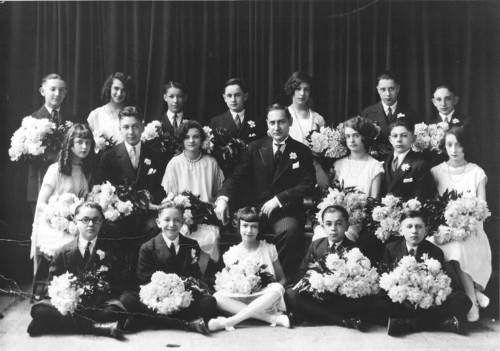Directions and Growth
History-making Directions and Growth
 The 1920s saw great change for Beth-El, as rabbinic leadership, religious affiliation, and geographic location all shifted, mirroring American history on a larger scale. The congregation and the country began the “Roaring Twenties” with a boom and left them with a bust. Following Julius Rappaport’s departure, the synagogue found a new spiritual leader in Rabbi Julian Gusfield, who officiated in the temple’s new structure at Palmer Square and Sawyer Avenue in the Logan Square neighborhood.
The 1920s saw great change for Beth-El, as rabbinic leadership, religious affiliation, and geographic location all shifted, mirroring American history on a larger scale. The congregation and the country began the “Roaring Twenties” with a boom and left them with a bust. Following Julius Rappaport’s departure, the synagogue found a new spiritual leader in Rabbi Julian Gusfield, who officiated in the temple’s new structure at Palmer Square and Sawyer Avenue in the Logan Square neighborhood.
The Palmer Square facility began as a humble clapboard house in the middle of a large vacant lot, but eventually grew to accommodate the richness of activity and spirit that Molner Hall once provided. Following patterns of Jewish migration within the city limits, the area around the Crystal Street synagogue became densely Orthodox; consequently, the facility, including Molner Hall, was sold to a growing traditional congregation. For several years, Beth-El worshiped in the small wooden house on Palmer and Sawyer until a proper structure was built.
After World War I, increasing prosperity and social mobility allowed enterprising Jewish families to gradually move up and out of the city. This movement initially created an Orthodox stronghold in the west urban neighborhood of Lawndale, which boasted 60 synagogues in the 1930s, as well as formidable concentrations of Reform and Conservative families in former Scandinavian neighborhoods to the northwest, such as Humboldt Park, Albany Park, Logan Square, and Rogers Park. Then, following World War II, the urban exodus culminated in a suburban population explosion that established a distinct Jewish presence all along the North Shore and well into the northwest suburbs.
Rabbi Gusfield maintained the trends of liberalization that Rabbi Rappaport had initiated, addressing the “need to encompass the American generation with the European generation” through programming, outreach and modification to the liturgy. Like Rappaport, Gusfield endeavored to unite the Beth-El community with other congregations across the city and country. This wish was fulfilled in 1923, when Beth-El affiliated with the Union of American Hebrew Congregations (UAHC), the country’s largest network of Reform synagogues and social organizations. This was Gusfield’s first action as tenured rabbi. Beth-El would then become a leading member of the Chicago Federation of the UAHC, a local consortium of synagogues that Rabbi Gusfield helped found.
Also that year, construction began for a proper gathering space on Palmer Square: Beth-El Center, designed by Edward Steinborn, which included a social hall and small sanctuary. The wooden house remained on the property, serving as a separate school building and continuing the tradition introduced by Julius Rappaport on Crystal Street. The construction project was not without great cost, and the congregation was obligated to take out a large mortgage to finance the endeavor.
For the next several years, the congregation continued its gradual shift toward liberalization, and by the time Rabbi Gusfield left the synagogue in 1927, Beth-El had come to occupy a curious position in terms of its religious practice. Separate from the Orthodoxy of the Lawndale synagogues and of the temple’s own predecessor, the Rodef Sholom Gemeinde, Beth-El was also distinct from the radical reforms of South Side synagogues such as Temple Sinai and Isaiah Israel, which held services in English on Sundays.
Many felt that Beth-El was at a crossroads, occupying a ritual middle ground that had no allegiance to any singular movement. This ambiguity of identity drove more than a few families to seek affiliation elsewhere, and, as the temple welcomed Rabbi Mayer Lipman to the pulpit, the issues of membership retention and spiritual practice were foremost on the temple board’s mind.
Rabbi Mayer Lipman easily transitioned into the space left by Julian Gusfield. He was the most religiously liberal leader that the synagogue had ever employed. He was also the first rabbi at Beth-El to be ordained at the Hebrew Union College (HUC), the academic arm of the UAHC and the institution most closely affiliated with Isaac Mayer Wise, whose prayer book had been in use for many years. Mayer Lipman was ordained from HUC in 1923, and, with his arrival at Beth-El just four years later, the young rabbi inherited a congregation that was unknowingly poised on the verge of disaster.
Fri, October 17 2025
25 Tishrei 5786
Quick Links
Email Us
Privacy Settings | Privacy Policy | Member Terms
©2025 All rights reserved. Find out more about ShulCloud



